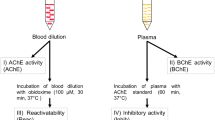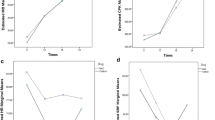Abstract
Oximes such as pralidoxime chloride reactivate acetylcholinesterase. However their role in management of organophosphate poisoning is controversial. The study was carried out to find effectiveness of pralidoxime chloride (2-PAM) in regenerating red cell acetyl cholinesterase in first 24 h following administration of it in dose recommended by WHO. Eight patients with OPP [chlorpyriphos (3), phorate (3), dichlorvos (1) and monocrotophos (1) who fulfilled the criteria for inclusion were investigated. In addition to decontamination and atropine, all these patients were administered 30 mg/kg body wt of 2-PAM as bolus dose followed by 7.5 mg/kg body wt/h with maximum dose being 500 mg/h as continuous infusion till first 24 h. Red cell AChE activity was estimated every 15 min for first 4 h, one hourly for next 4 h and then 2 hourly till 24 h and subsequently without 2-PAM every 12 h till 7 days or discharge or death which ever earlier. In all the patients maximum increase in activity was observed in first 4 h following which rise was very slow despite continued 2-PAM infusion and reaching a steady state in 20 h in all the cases. The increase in red cell AChE activity observed in diethyl group at 24 h of 2-PAM infusion was 154% vs. 81% in dimethyl group. At 7 days the increase in activity was 215% vs. 118% respectively. However on multiple repeated ANOVA, no statistically significant difference was observed between diethyl and dimethyl groups at admission and discharge (P > 0.05). Similarly no significant difference was observed in three groups when patients were categorized according to WHO classification of organophosphates (P > 0.05). The maximum increase in red cell AChE activity occurs in first 4 h of 2-PAM administration followed by a slow increase despite 2-PAM infusion till 24 h.

Similar content being viewed by others
References
Schumacher M, Camp S, Maulet Y, Newton M, Macpheequigley K, Taylor SS, Friedmann T, Taylor P. Primary structure of acetylcholinesterase—implications for regulation and function. Fed Proc. 1986;45:2976–81.
Brunton L, Lazo J, Parker K, Goodman, Gilman’s. The pharmacological basis of therapeutics. New York: Mc Graw Hill; 2006.
Bajgar J. Organophosphates/nerve agents: mechanism of action, diagnosis prophylaxis and treatment. Adv Clin Chem. 2004;38:151–216.
Weinbroum A. Pathophysiological and clinical aspects of combat anticholinesterase poisoning. Br Med Bull. 2004;72:119–33.
Singh S, Chaudhry D, Behera D, Gupta D, Jindal SK. Aggressive atropinisation and continuous pralidoxime (2-PAM) infusion in patients with severe organophosphate poisoning: experience of a northwest Indian hospital. Hum Exper Toxicol. 2001;20:15–8.
Kassa J, Cabal J. A comparison of the efficacy of a new asymmetric bispyridinium oxime BI-6 with presently used oximes and H oximes against sarin by in vitro and in vivo methods. Hum Exper Toxicol. 1999;18:560–5.
Worek F, Backer M, Thiermann H, Mast U, Klimmek R, Eyer P. Reappraisal of indications and limitations of oxime therapy in organophosphate poisoning. Hum Exper Toxicol. 1997;16:466–72.
Eyer P. The role of oximes in the management of organophosphorous pesticide poisoning. Toxicol Rev. 2003;22:165–90.
Eddleston M, Szinicz L, Eyer P, Buckley N. Oximes in acute organophosphorus pesticide poisoning: a systematic review of clinical trials. Q J Med. 2002;95:275–83.
Ellman GL, Courtney KD, Andres V, Featherstone RM. A new and rapid colorimetric determination of acetylcholinesterase activity. Biochem Pharmacol. 1961;7:88–95.
Eyer P, Worek F. The determination of human erythrocyte acetylcholinesterase (Ery–AchE) in a modified Ellman assay. In: Proceedings of CB medical treatment symposium. Germany: Walther-Straub-Institut für Pharmakologie und Toxikologie der Ludwig-Maximilians-Universität München; p. 1–6.
BalaSubramaniam P, Malathi A. Comparative study of hemoglobin estimated by Drabkin’s and Sahli’s methods. J Postgrad Med. 1992;38:8–9.
Aggarwal HC, Pillai MK, Yadav DV, Menon KB, Gupta RK. Residues of DDT and its metabolites in human samples in Delhi, India. Bull World Health Org. 1976;54:349–51.
Marrs TC, Maynard RL, Sidell FR. Chemical Warfare agents. Toxicology and treatment. Chicester: John Wiley and Sons; 1996. p. 1–243.
Dishovsky CD, Kagan Y, Kortun S. Electrophysiological análysis of action produced by the reactivator dipiroxime in acute poisoning with O,O-dimethyl-2,2-dichlorvinyl-phosphate. Pharm Toxicol. 1974;3:365–7.
Dishovsky CD. Some aspects of the mechanism of action of oxime reactivators of cholinesterase. In: Monov A, Dishovsky C, editors. Medical aspects of chemical and biological terrorism-chemical terrorism and traumatism. Sofia Bulgaria: Publishing House of Union of Scientists in Bulgaria; 2005.
Eyer P, Hell W. Chemical stability of the Hagedorn oximes HGG-12 and HI-6. Arch Pharmacol. 1985;318:938–46.
Gresaru D, Sternfeld M, Elder A, Glick D, Soreq H. Structural roles of acetyl cholinesterase variants in biology and pathology. Eur J Biochem. 1999;264:672–86.
Eddlestone M, Eyer P, Worek F, Mohamed F, Senarathna L, Meyer L, et al. Differences between organophosphorus insecticides in human self poisoning: a prospective cohort study. Lancet. 2005;366:1452–9.
Ageda S, Fuke C, Ihama Y, Miyazaki T. The stability of organophosphorus insecticides in fresh blood. Legal Med. 2006;8:144–9.
Author information
Authors and Affiliations
Corresponding author
Rights and permissions
About this article
Cite this article
Goel, P., Gupta, N., Singh, S. et al. Regeneration of Red Cell Cholinesterase Activity Following Pralidoxime (2-PAM) Infusion in First 24 h in Organophosphate Poisoned Patients. Ind J Clin Biochem 27, 34–39 (2012). https://doi.org/10.1007/s12291-011-0152-0
Received:
Accepted:
Published:
Issue Date:
DOI: https://doi.org/10.1007/s12291-011-0152-0




